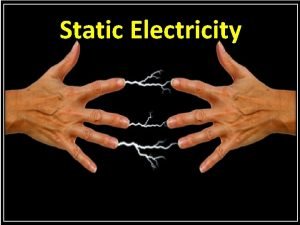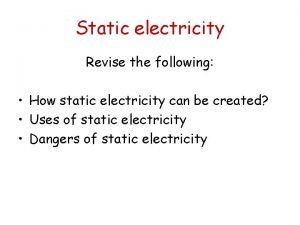Static Electricity Electrostatics Examples of electrostatic discharges Lightning










- Slides: 10

Static Electricity

Electrostatics • Examples of electrostatic discharges – Lightning – “foot dragging” – static cling in dryers – “shocking” cats • Electrical charges come in two types, + and – – Amber (Gk. electron) is associated with – – Glass is associated with + • Charging: – By induction – By conduction (conductors and insulators)

Electrical Charges • Negative (electron) • Positive (proton) • Opposite charges (+ and –) attract whereas like charges (+ and + or – and –) repel • Charge is measured in Coulombs, C • Quantities of charge – Electron = -1. 6 x 10 -19 C – Proton = +1. 6 x 10 -19 C

Electric Field Lines • Directed from positive to negative charge • Show the path that a positive unit test charge would take. • Account for action-at-a-distance forces.

Electric Field Strength • • E = Fe/q by definition (force per unit charge) Or Fe = Eq (where E = electric field strength) Units of E are N/C Parallels W = mg (where g = grav field strength)

Coulomb’s Law • First worked out using a torsion balance • Pendulum apparatus easier to understand – Fe = mg tan(θ) found proportional to q 1 and q 2 – Fe = mg tan(θ) found inversely proportional to r 2 – Fe = keq 1 q 2/r 2 where ke = 9 x 109 Nm 2/C 2 • Parallels Newton’s universal law of gravitation – Fg = Gm 1 m 2/r 2 where G = 6. 67 x 10 -11 Nm 2/kg 2 – Note that Fe/Fg = 4. 17 x 1042; therefore Fe >>>> Fg

Why Gravity Dominates in Universe • Because Fe/Fg = 4. 17 x 1042 and Fe >>>> Fg, then why does gravity dominate in the universe? • The universe is “neutral” in terms of overall charge; that is, the number of electrons is balanced by the number of protons. • Individual objects are most commonly neutral because they contain roughly equal numbers of positive and negative charges.

A Couple of Examples • Fe = keq 1 q 2/r 2 where ke = 9 x 109 Nm 2/C 2 – Analogously Fg = Gm 1 m 2/r 2 – However, Fg is only attractive (unless we are talking the grand scale of the universe. . . ) whereas Fe can be either attractive or repulsive • Fe = q. E – Analogously W = mg – This is why g is sometimes called the gravitational field strength and is expressed in units of N/kg

E. C. HW Problems (1/3 pt ea) 1. What is the direction of the field 1 m away from the 1 C charge, in or out of the 1 C charge? 2. What force would a 1. 4 x 10 -5 C negative charge experience at 1 m distance from the 1 C positive charge? 3. Would the force be directed toward or away from the 1 C charge?

E. C. Homework Note • Because Dr. Wenning will be gone for two weeks, please submit your E. C. homework solutions in hard copy at the start of the next class period.
 Static electricity and current electricity
Static electricity and current electricity Current electricity gif
Current electricity gif How are static electricity and current electricity alike
How are static electricity and current electricity alike Chapter 32 admissions transfers and discharges
Chapter 32 admissions transfers and discharges Types of fire hose rolling
Types of fire hose rolling Static electricity examples
Static electricity examples The law of charges
The law of charges Static electricity
Static electricity How does static electricity work
How does static electricity work Bill nye electricity
Bill nye electricity What year was electricity invented
What year was electricity invented


















